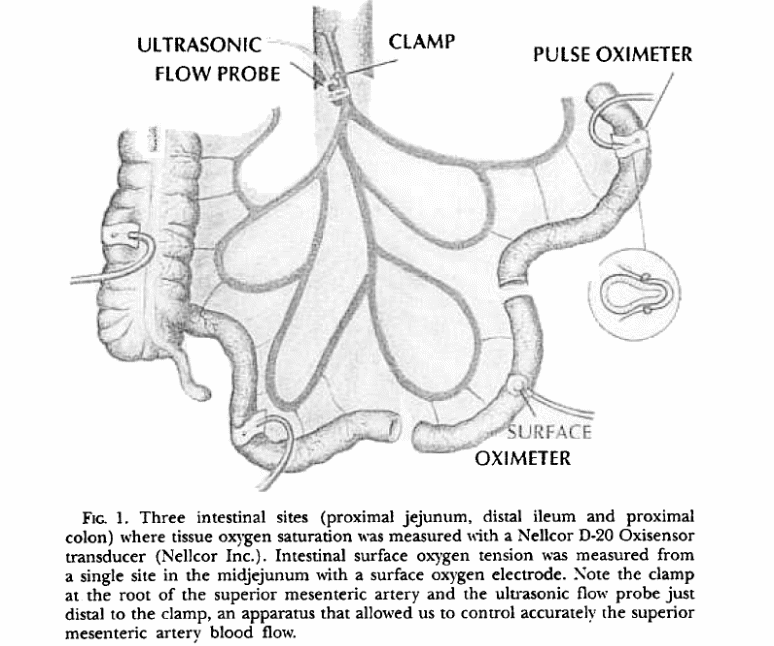Introduction
The human colon is a dynamic organ, involved in a vast array of functions, including the absorption of water and electrolytes, the salvage of unabsorbed nutrients, and the transport of luminal contents as faeces. While not an organ essential for life, the colon still plays a major role in maintaining the overall health of the human body. The embryology of the colon informs its anatomy. Colon ischaemia is the inadequate supply of blood to its tissue, resulting in damage to the tissue due to a lack of oxygen and the subsequent built up of metabolic waste.
Reduced blood flow can occur due to several factors such as compromised cardiac function, blood vessel constriction or blockage, or changes to local blood flow. Previous research that involved measuring using pulse oxymetry to check oxygen saturation of the bowel and evaluation of the relationship between these measures and concomitant pathological grading revealed that intraoperative evaluation of intestinal blood flow viability by pulse oximetry may give an idea about the degree of pathological changes.
A reflectance pulse oximetry of the colon mucosa was applied in an animal model during aortic reconstruction. It was shown to be useful in monitoring the blood flow of the distal colon. Pulse oximetry has been shown to be applicable as an adjunct technique in the assessment of small bowel ischemia in a patient with a strangulated ileus. In a recent study, a novel reflectance pulse oximetry technique was introduced for intraoperative measurements of SpO2 in the esophagus and large bowel. The method has been proven to be able to measure SpO2 continuously in patients with a compromised peripheral perfusion.

The Pulse Oximeter Technique
The pulse oximeters use a spectrophotmetric method to determine the proportion of unsaturated to saturated haemoglobin in arterial blood. The procedure uses two different light sources in a high frequency alternating manner, one emitting red light with a wavelength of 660 nanometres and a second emitting infrared light with a wavelength of 940 nanometres. Oxyhaemoglobin absorbs less red light than does deoxyhaemoglobin and at infrared wavelengths, the opposite is true.
The pulse oximeter was designed to measure the oxygen saturation of arterial blood only; however, a tissue bed is com- posed not only of arterial blood, but also of venous blood and soft tissue, which will also absorb light. The pulse oximeter accounts for this “background” absorbance by the fact that, during systole, the amount of arterial blood in a tissue bed increases and, therefore, total light absorbance will reach a maximum. The opposite occurs during diastole, when light absorbance reaches a minimum.
In tissue beds that are not very metabolically active and, thus, have a low tissue oxygen extraction, that is, the ear lobe or the tip of the finger, blood flow will have less effect on pulse oximetry determined oxygen saturation. However, in tissue beds that are very metabolically active, blood flow can have a significant effect on pulse oximetry measured oxygen saturation. It is on this principle that pulse oximeters may be useful in estimating intestinal tissue blood flow.
Conclusion
Pulse oximetry is not perfect, however. Small patients with small arteries, such as cats, are difficult to monitor because of decreased circulation to the extremities under anaesthesia and their small blood vessel size. The tongue sensor cannot be used if the procedure being done involves the mouth or head of the patient. The rectal probe is subject to dislodgement by stool in the colon. Sometimes other monitors are used instead.
Bibliography
Alexander, C. M., L. E. Teller, and J. B. Gross, “PrincipIes of pulse oximetry.” Anesth. Analg, vol. 68, 1989, pp. 368-376.
Bowes, W. A., B. C. Corke, and J. Hulka, “Pulse oximetry: a review of the theory, accuracy and clinical applications.” Obstet. Gynecol, vol. 74, 1989, pp. 541-536.
DeNobile, N., P. Guzzetta, and K. and Patterson, “Pulse oximetry as a means of assessing bowel viability.” J. Surg. Res, vol. 48, 1990, pp. 21-23.
MacDonald, P. H., P. K. Dinda, I. T. Beck, and C. D. Mercer, “The use of Oximetry in Determinng Intestinal Blood Flow.” Gynecology & Obstetrics, vol. 176, 1993, pp. 451-457.
Prokopiw, l., P. K, Dinda, and l. T. Beck, “Regional differences in the vascular response of the canine esopbagus to Vasolidators.” Gastroenterology, vol. 97, 1989, pp. 42-47.
Sheridan, W. G., R. H. Lowndes, and H. L. Young, “1n~aoperative tissue oximetry in the human gastrointestinal tract.” Ain. l. Surg., vol. 159, 1990, pp. 314-319.
Tremper, K K., and S.J. Barker, “Pulse oximetry.” Anesthesiology, vol. 70, 1989, pp. 98-108.
Welch, M., Baguneid, M. S. et al “Histological study of colonic ischaemia after aortic surgery.” Br J Surg, vol. 85 (8), 1998, pp. 1095-1098.